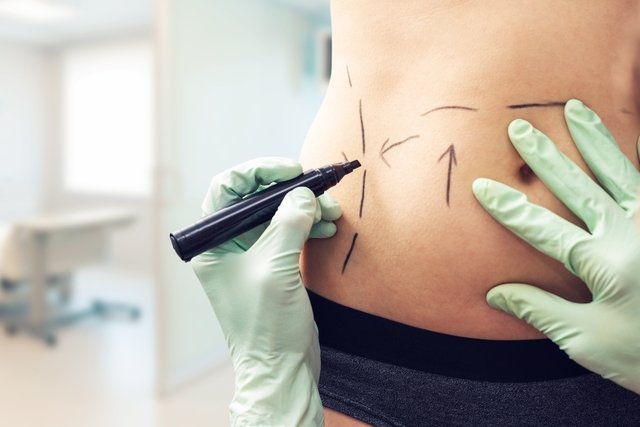The post-operative period of abdominoplasty requires a lot of rest during the first 10 days and full recovery takes around 2 months. However, some people undergo abdominoplasty and abdominal liposuction or mammoplasty at the same time, making recovery a little longer and more painful.
In addition to resting, it is recommended that the person wear a modeling belt and compression stockings, to prevent the accumulation of liquid in the area and prevent the formation of clots.
After leaving the clinic, day-to-day activities can be resumed little by little as long as they do not cause pain or discomfort. However, it is important to take some precautions, such as sleeping on your back, walking with your torso bent and not taking off the brace until advised by your doctor, in order to avoid possible complications, such as opening stitches or infection. Learn about the possible complications of abdominoplasty.

1. Use a compression strap and stockings
After abdominoplasty surgery, it is normally recommended that the person wear a waist trainer to protect the belly and prevent the accumulation of fluid near the scar, which is known as seroma. The belt also helps to provide comfort to the person and facilitate movement.
It is recommended that the modeling belt be used for 30 to 60 days, in accordance with medical advice, and it is recommended that it be removed only to take a shower. It is important that the belt is removed carefully at this point and that the person remains in a more curved posture, especially in the first few weeks after surgery, to reduce the risk of complications.
Compression stockings can also be recommended during recovery from abdominoplasty to facilitate circulation and prevent the formation of clots, and can be removed when taking a shower.
2. Rest
Rest is recommended for the first two weeks after surgery, or as advised by your doctor, to avoid opening the stitches and possible complications. To walk, it is recommended that you bend your torso, curving your back and resting your hands on your belly as if you were holding it, as this position provides greater comfort and relieves pain, and should be maintained for the first 15 days or until stop feeling pain.
Furthermore, when sitting, you should opt for a chair, avoiding benches, leaning back completely and resting your feet on the floor.
After abdominal surgery, it is essential to sleep on your back, lying down and with your legs bent, avoiding sleeping on your side or stomach, so as not to put pressure on the abdomen or hurt the scar.
If you have an articulated bed at home, you must elevate the torso and legs, however, in a normal bed you can place semi-rigid pillows on the back, helping to elevate the torso, and under the knees, to lift the legs. You must maintain this position for at least 15 days or until you no longer feel discomfort.
3. Move
Despite the recommendation to rest, it is important to move carefully to avoid the formation of clots, which is why it is recommended to move your legs and feet every 2 hours, in addition to massaging your legs morning and night. If you can walk without pain, you should walk several times a day, slowly, wearing comfortable clothes and wearing sneakers, as recommended by your doctor.
However, it is important for the person to avoid making great efforts and lifting weights for 30 days after abdominoplasty, and can gradually return to physical activity according to the doctor’s instructions.
4. Perform lymphatic drainage
Lymphatic drainage can be indicated from the 4th day after surgery and aims to activate local circulation, promote recovery and prevent the accumulation of liquid in the area. Understand how lymphatic drainage is done.
5. Take care of the drain
The surgical dressing is normally removed after 24 hours, however, in some cases, the person may remain with the drain for a few weeks to drain the blood and liquids accumulated in the operated area. The drain is inserted at the site of the scar and must only be removed in the hospital. Check out how to care for the drain.
6. Have a light diet
It is important to have a light diet after undergoing abdominoplasty, and the following may be recommended:
- Going 4 hours without eating nor drink to avoid nausea and vomiting, as the effort to vomit can open the scar;
- 5 hours after surgery you can eat toast or bread and drink tea, if you have not vomited;
- 8 hours after surgery you can eat broth, strained soup, drink tea and bread.
The day after surgery, you should maintain a light diet, opting for cooked or grilled foods and without sauces or condiments. Furthermore, it is essential to drink plenty of water or tea and eat fruits and vegetables to avoid constipation that increases pain in the abdomen.
What to do to relieve the pain
After abdominoplasty, it is normal to feel pain in the stomach due to the surgery and pain in the back, as you spend a few days always lying in the same position. To relieve abdominal pain, it is essential to take the medicines prescribed by your doctor, such as Paracetamol, following the quantities and times indicated.
When having a bowel movement, the pain may increase and, therefore, to make going to the bathroom easier, you can take fiber-based supplements, such as Benefiber. Furthermore, to treat pain in the lower back, you can massage the area with a relaxing cream or place hot water washcloths to reduce tension.
When to go to the doctor
A visit to the doctor is recommended after 15 days to have the stitches removed. However, it is essential to consult a doctor when some changes are noticed, such as:
- Difficulty breathing;
- Fever greater than 38ºC;
- Pain that does not go away with the painkillers prescribed by the doctor;
- Stains of blood or other liquid on the dressing;
- Severe pain in the scar or foul smell;
- Signs of infection such as a hot, swollen, red and painful area;
- Excessive tiredness.
In these cases, it is important to consult a doctor, as an infection may be developing in the scar, a pulmonary embolism or anemia, for example, and it may be necessary to begin treatment for the problem.

Sign up for our newsletter and stay up to date with exclusive news
that can transform your routine!
Warning: Undefined array key "title" in /home/storelat/public_html/wp-content/plugins/link-whisper-premium/templates/frontend/related-posts.php on line 12
Warning: Undefined array key "title_tag" in /home/storelat/public_html/wp-content/plugins/link-whisper-premium/templates/frontend/related-posts.php on line 13



